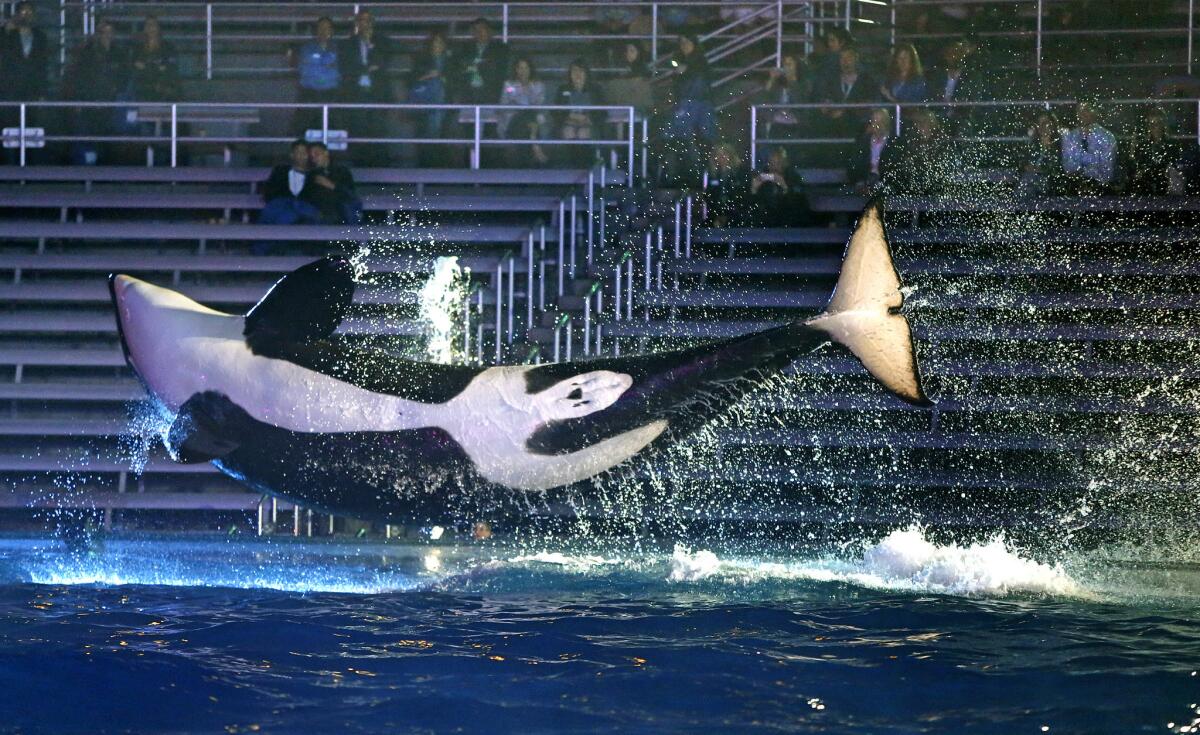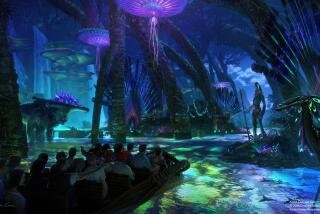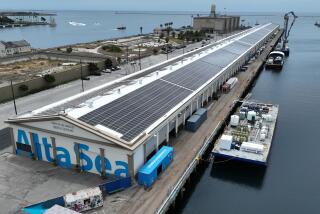Embattled SeaWorld to overhaul killer whale show

A trained orca killer whale leaps into the air at SeaWorld in San Diego.
- Share via
It started with a killer whale named Shamu, who arrived at SeaWorld San Diego shortly after it opened half a century ago. The orca show quickly became the park’s signature attraction, drawing crowds to see leaps, spins and comedic exchanges with prancing trainers.
That era will soon come to a close, when SeaWorld — under pressure from animal-rights critics and sagging attendance — replaces the circus act with more of a nature show.
SeaWorld Entertainment Inc. announced Monday that it will end the Shamu show next year and launch a “new orca presentation” in 2017 that will tone down the theatrics and focus on more natural whale behavior. Park representatives declined to provide details or to reveal plans for orca shows at other locations.
The move is part of a broad plan to reassure investors and appease critics, including state and federal lawmakers threatening to outlaw SeaWorld’s hugely popular orca shows.
The changes reflect rising pressure on SeaWorld and other animal entertainment operations, including circuses and zoos, as public attitudes on animal welfare evolve. SeaWorld is coping with backlash from the 2013 documentary “Blackfish,” which accused the company’s parks of mistreating killer whales. The reaction has driven down attendance, revenue and the company’s stock value.
Still, SeaWorld Entertainment Chief Executive Joel Manby, who took over his post in March, insisted that the company seeks to please customers, not critics.
“We don’t do anything in San Diego in response to activists,” he said during an investor presentation Monday in Orlando, Fla. “We do it because we have heard from our guests.”
Manby also hinted that the company will shelve plans to spend $100 million for a larger enclosure for the 11 whales at SeaWorld San Diego. It’s a project that drew criticism from animal rights groups and state lawmakers who proposed tough conditions on the project, dubbed Blue World.
“We can achieve our objectives without doing the Blue World,” he said.
Instead, he said, the company will likely spend one-third to one-half of that money on a new attraction that won’t involve killer whales. Manby was short on specifics about the new San Diego attraction, but he said he expects to draw big crowds with a new roller coaster that will open next year at SeaWorld Orlando.
The company will also simplify ticket discount offerings, emphasize how economical SeaWorld parks are compared with other theme parks, and reach out to millennials and families who want to learn about the environment while being entertained.
Rescue teams at SeaWorld San Diego and Orlando save hundreds of animals each year, including whales and other mammals tangled in nets and ropes, as well as birds caught in oil slicks.
SeaWorld’s latest move isn’t appeasing critics, who have called on the park to release its whales to ocean sanctuaries.
“This move is like no longer whipping lions in a circus act but keeping them locked inside cages for life,” said Jared Goodman, director of animal law for the People for the Ethical Treatment of Animals.
The announcement also didn’t placate Rep. Adam Schiff (D-Burbank), who said Friday that he intends to introduce legislation that would ban the breeding of whales in captivity.
“The fact still remains that as long as SeaWorld holds orcas in captivity, the physical and psychological problems associated with their captivity will persist,” he said in a statement.
Although attendance has fallen over the last year, the rate of decline has slowed recently, which SeaWorld executives attribute to a $15-million campaign of TV commercials and online ads responding to animal rights critics.
In 2014, attendance at SeaWorld’s 11 parks dropped 4.2%. In the quarter that ended Sept. 30, attendance fell only 0.4%. The biggest attendance declines came at SeaWorld’s parks in San Antonio and San Diego, which the company attributed to bad weather in Texas and the effects of “Blackfish” in San Diego.
SeaWorld was dealt another blow last month when the California Coastal Commission approved SeaWorld’s $100-million plan to expand the whale enclosure but added the condition that the park end its killer whale breeding program and halt the transfer of new whales to the park. The conditions would eventually put an end to the park’s most popular attraction.
SeaWorld said it plans to challenge the commission’s decision in court. The company has retained lawyers for the challenge but has yet to file a lawsuit. If SeaWorld decides not to pursue the project — as Manby suggested Monday — the company can continue its whale breeding program within its existing enclosures.
The commission’s ruling was key to forcing SeaWorld to reconsider what kind of company it wants to be, which likely led to the initiatives unveiled Monday, according to a marketing and branding expert from San Diego State.
“They have finally figured out that their business model is broken,” said Bernhard Schroeder, director of the university’s Lavin Entrepreneurship Center.
Among other ideas proposed to boost revenue, SeaWorld Entertainment said Monday that it would partner with San Diego-based Evans Hotels to investigate plans to build a resort hotel on property adjacent to the San Diego park.
It seemed clear from Manby’s response to analyst’s questions Monday that killer whales will continue to be featured prominently at the SeaWorld parks.
While the existing “One Ocean” show at Shamu Stadium in San Diego includes music, videos and whale tricks such as the giant mammals’ splashing the audience, Manby said the new show will instead demonstrate how the whales behave in the wild, with a focus on conservation efforts.
The reaction from SeaWorld visitors was mixed Monday.
Christine Saponara, 35, a city planner from Los Angeles, arrived at SeaWorld late Monday morning and expressed relief that SeaWorld was backing away from its traditional orca shows. She said there are too many signs that killer whales are both highly intelligent and are suffering under current circumstances.
“It’s a good thing,” she said. “Maybe we can see things in a more natural way.”
Others complained that animal rights activists were pushing SeaWorld too far.
“I think PETA is a little bit too extreme,” said Navy engineer Makoto Sugiyama of Rancho Cucamonga, who was pushing a stroller with his daughter toward the SeaWorld entrance gates Monday.
Kathleen Dezio, executive director of the Alliance of Marine Mammal Parks & Aquariums, applauded SeaWorld’s latest move, saying the company seemed to be responding to its customers.
“This is just one more indication that they are listening to their guests,” she said.
News of SeaWorld’s plans caused an initial stock surge, but shares ended the day down 1.27% to $17.91. Company shares have lost nearly half their value since “Blackfish” was released.
Analyst James Hardiman, who covers SeaWorld for Wedbush Securities, said it was smart of SeaWorld to retool the orca show “and I think it shows that the new management team is willing to put everything on the table and tackle some of the taboos that the prior team was unwilling to address.”
Twitter: @hugomartin
San Diego Union-Tribune reporters Lori Weisberg, Jennifer Van Grove and Morgan Lee contributed to this report.
For more tourism news, follow Hugo Martin on Twitter: @hugomartin
MORE FROM BUSINESS
Is the FCC ready to think outside the set-top box?
SeaWorld’s new plans for Shamu make a splash on the Internet
Does VW ‘goodwill’ payment clause prevent owners from suing?
More to Read
Inside the business of entertainment
The Wide Shot brings you news, analysis and insights on everything from streaming wars to production — and what it all means for the future.
You may occasionally receive promotional content from the Los Angeles Times.











